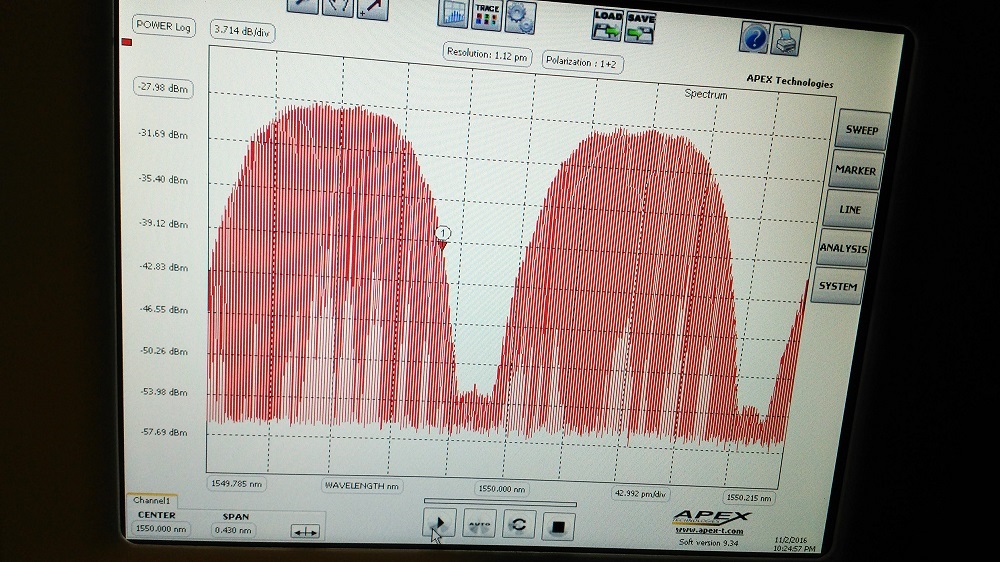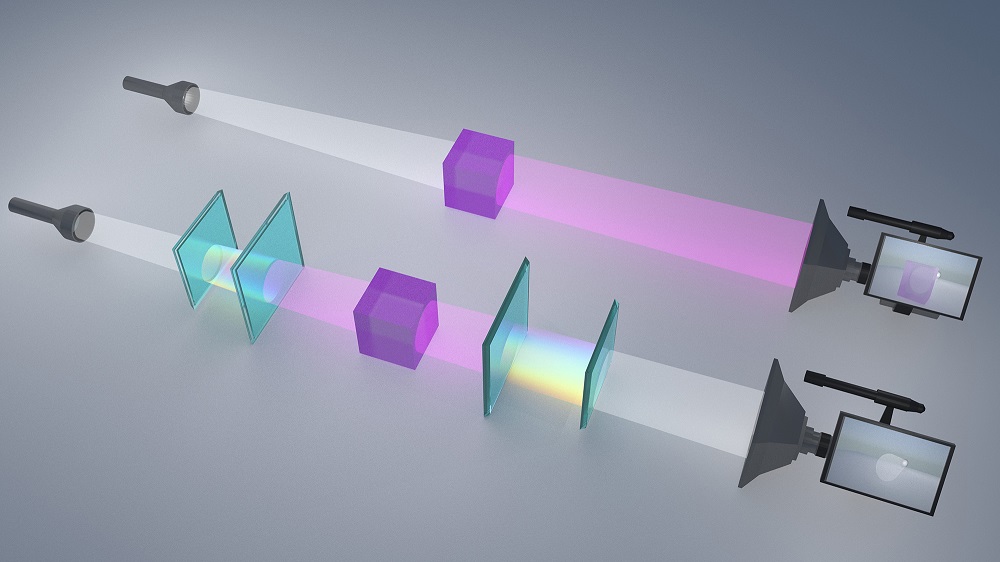July 24, 2018
The past decade has seen the emergence of numerous technologies designed to conceal objects by changing the way they interact with light. But all of these methods share one major weakness: they are ineffective under realistic broadband illumination, e.g., light consisting of all the colors of the rainbow, like natural light. Now, for the first time, Professor José Azaña and his team of researchers at INRS have demonstrated the effectiveness of a groundbreaking new invisibility cloak concept in successfully concealing an object illuminated by a broadband light source. Their discovery, published in the prestigious journal Optica, has immediate potential applications in telecommunications and computer security.
Our eyes perceive objects around us based on their interaction with light. A blue flower, for example, looks that way to us because among all the frequencies of the electromagnetic spectrum emitted by the sun, only those corresponding to the color blue are scattered or reflected by its petals. In other words, what we see is determined by the way in which objects interact with light waves.
The solutions envisaged to date for invisibility cloaking generally involve deflecting light around an object so that the light and the object do not interact. In theory, observers will be unable to see the object, because the light reaching their eyes is unaltered. Some of these technologies work well at the microscopic level, on the condition that only one frequency—i.e., one color of light—is used. However, sunlight and most artificial light sources consist of a broad range of wavelengths or colors, i.e., a polychromatic spectrum. Light made up of several colors poses a major challenge because each color travels at a different speed inside invisibility devices developed to date; this results in easily detectable distortions that give away the presence of the cloak.
The new technique developed by José Azaña and his team does not deflect light around the target. Instead, it manipulates the frequencies or colors of the light waves that pass through the object to ensure that it remains undetectable. “For the first time, we have demonstrated that an object illuminated by a broadband polychromatic light source can be made invisible without the light source being affected in any way by the object,” explained José Azaña. “This achievement was made possible by an entirely new conceptual approach to invisibility.”

The movement of light waves during spectral camouflage
Spectral camouflage, or modifying the rainbow
In the experiment described in Optica, the goal of the team was to make an optical filter “invisible.” The filter is a semi-transparent object that absorbs some colors and lets others pass through, emulating the way an object generally interacts with light. When broadband light is launched through the filter, some of the colors within the light spectrum are altered, revealing the presence of the filter. To create the desired invisibility effect, light propagating through the filter must be perceived in its original state, just as it was emitted by the source, as if the filter did not exist.
José Azaña and his team proposed and experimentally demonstrated a new theoretical concept to create their invisibility cloak: the key is to disguise the colors of the incoming light wave that are likely to interact with the object (i.e., those that would be reflected or absorbed) by converting them into colors that will be unaffected by the object. After propagating through the object, the outgoing light wave is restored to its exact original state, as if there had been no object along its path.
The new invisibility cloak operates in two steps, and thus has two main components. The first component is located between the light source and the filter, whereas the second one is located at the end of the light path, between the filter and the observer (e.g., a detector). Each component in turn comprises two items: an optical fiber that separates the colors of the incoming light by forcing each color of the spectrum to travel at a different speed, and a device known as a temporal phase modulator, which is used to change the frequency of a given color depending on when it reaches the device. In short, through this design, each of the components in the cloaking system implements a programmable device that can be used to modify the energy of a specific color and transform it into another color at will.
Let’s take, for example, an optical filter that absorbs the green color. By modifying the frequency of the green in the light beam so that it becomes blue, all interaction between the light and the filter, which is sensitive to green, is prevented. But the light has been altered. The second component of the invisibility cloak restores the green that was transformed in the first step of the operation. The result? The light passes through the filter without interacting with it and is then restored to a form identical to the light emitted by the source. This makes the object (filter) completely invisible to the observer!
For now, full invisibility under polychromatic light has been demonstrated by illuminating the object from one direction only, in order to validate the basic concept under controlled conditions. The experiment has shown the effectiveness of this new approach under broadband illumination. “It’s a very promising concept, but we’ll need to test and develop it further to determine how far we can go in optimizing and adapting the concept to different practical applications," explained Professor Azaña. In theory, the concept could be extended to conceal three-dimensional objects by using multiple component pairs or successive device layers. The only information necessary is the spectral response of the object to be concealed, i.e. the range of colors that will be affected by the object and those that will simply pass through the object without interacting with it
The demonstrated one-dimensional invisibility cloak is already of potential interest for a variety of important applications, especially in the context of fiber-optic telecommunication systems. For example, current telecommunication systems use broadband light waves as data signals to transfer and process information. By using the new device to reorganize the colors of the spectrum of these waves, sensitive data could potentially be protected by “cloaking” certain segments of the telecommunications network from prying eyes. In addition to concealment and invisibility, this new technique could also be used to tackle important issues currently affecting broadband telecommunications. Data transmission quality could be improved, for example, by reorganizing the frequency spectrum of the propagating waves to reduce their vulnerability to dispersion, non-linear phenomena, and other undesirable impairments that are often strongly related to the frequency (color) range of the data signal. ♦

Professor José Azaña and Luis Romero Cortés, doctoral student in telecommunications and co-author of the article published in the journal Optica, in their laboratory at INRS
The article “Full-field broadband invisibility through reversible wave frequency-spectrum control” was published in the journal Optica on June 28, 2018 (DOI : 10.1364/OPTICA.5.000779). The authors are Luis Romero Cortés, Mohamed Seghilani, Rezan Maram, and José Azaña from INRS. This research was financially supported by Fonds de recherche du Quebec nature et technologies (FRQNT) and the Natural Sciences and Engineering Research Council of Canada(NSERC).













